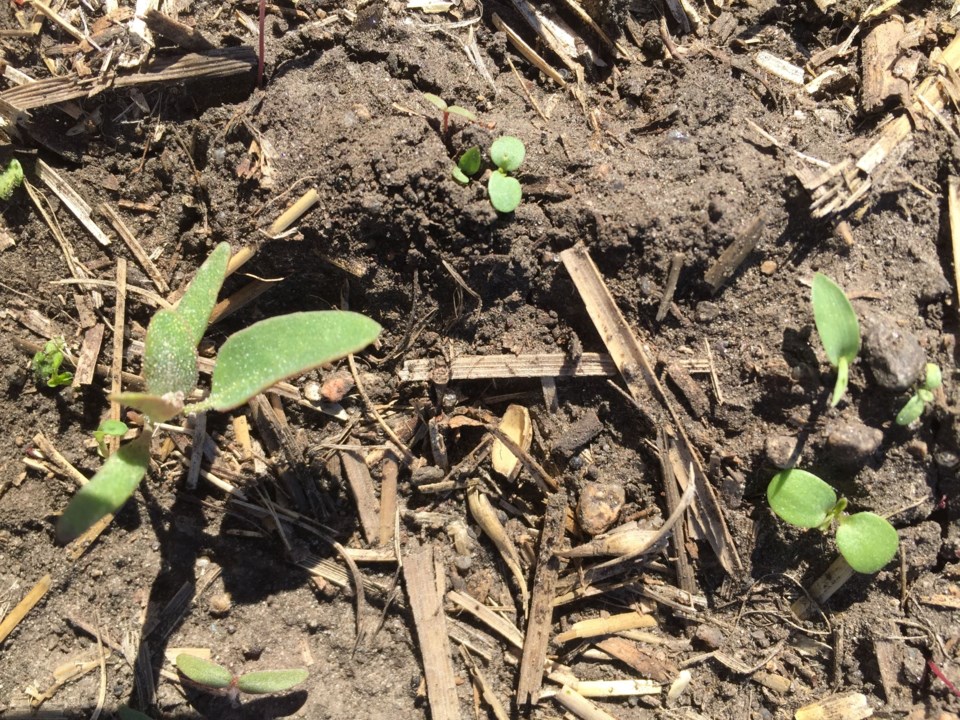Weeds that emerge before the crop will out-compete the crop for moisture, nutrients and sunlight. That is why just a small number of weeds – even just a few per square foot – emerging before or with the crop can be much more damaging to yield potential than a larger number of weeds flushing later.
Agriculture and Agri-Food Canada (AAFC) weed scientists Neil Harker and John O’Do-novan estimated that the yield effect of one weed emerging a week before the crop is equivalent to that of 100 weeds emerging three weeks after the crop.
Another AAFC canola study found that weed control was more important than any other major input. A summary in the Canola Digest Science Edition of 2013 reads: “In a bar-ley-canola rotation, the primary input that influenced yield was weed control. Without weed control, the addition of genetics, a higher seeding rate and nitrogen fertilizer had no impact on net return.”
University of Saskatchewan research led by Ken Sapsford and Rick Holm found that, in terms of yield, early weed control is even more beneficial than early seeding – even if you won’t be seeding for a couple of weeks. While this particular study was done on wheat, Sapsford says results would be similar for canola. Clark Brenzil, Saskatchewan’s provincial weed control specialist, described this U of S research in a recent Canola Watch podcast. The study compared yields for three combinations: early weed control with seeding the day after, early weed control with late seeding, and late weed control with late seeding. “The first two treatments yielded similarly, whereas the burnoff done just before the later seeding date had a reduction in yield compared to the other two,” Brenzil says.
His recommendation: “Your sprayer can travel a lot better on fields that aren’t suitable for seeding, so get the pre-seed burnoff done early over all your fields and then start seeding.”
Pre-seed burnoff: Tips for best results
Check that weeds are present. Perennials and winter annuals not controlled in the fall will get larger by the day. Getting them early will make them easier to control – rather than waiting for them to get any bigger. With a walk through the field, you’ll probably also find small annuals starting to emerge. Early weed control with lower efficacy is gen-erally preferable to no control at all or late control with higher efficacy — as long as weeds are not frost damaged. Any weed flushes that emerge later can be hit with an early in-crop application.
Assess frost damage. After a frost, wait for at least one night with a low of 5°C or warmer and one day of warm, sunny conditions. If heavy frost caused tissue damage to more than 40% of weed leaf area, wait for new growth to show before spraying. If spray-ing was done more than 48 hours before a frost event, efficacy on living plants will be retained and the plant will continue to decline when it warms up again.
Wait for warm, sunny daytime conditions. This is especially helpful when targeting perennials or winter annuals that may be a little larger. Ideally, you want a day or two of warm sunny days and night time lows of 4°C or higher before spraying.
Add a tank mix to glyphosate. Two main reasons for this are: One, the tank mix re-duces selection pressure for glyphosate-resistant weeds, protecting glyphosate as an effective mode of action. Two, using two modes of action can improve weed control, es-pecially for weeds like cleavers and kochia. Tank mix options for glyphosate applica-tions ahead of canola are bromoxynil, carfentrazone, quinclorac and clomazone. Bro-moxynil and carfentrazone are foliar contact herbicides, which work better with high wa-ter rates. Quinclorac provides foliar systemic control in addition to soil activity. Cloma-zone is an active herbicide that only works on cleavers that germinate after application. Tank mixing will also mean good sprayer clean-out required between fields, but the ex-tra effort is worth it to protect glyphosate efficacy for the long term
The Weed Management section at canolaencyclopedia.ca has more on pre-seed burnoff applications. To listen to the “Early weed control” April 20 podcast with Clark Brenzil, go to soundcloud.com and search for the Canola Watch podcast.
–Ian Epp is an agronomy specialist with the Canola Council of Canada. Email [email protected]. This canola management tip is brought to you by canolawatch.org, a collaboration of the Canola Council, SaskCanola, Alberta Canola and Manitoba Canola Growers.




